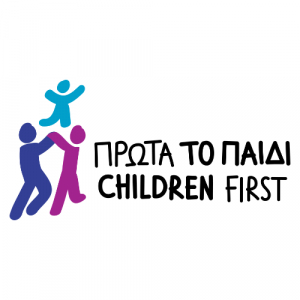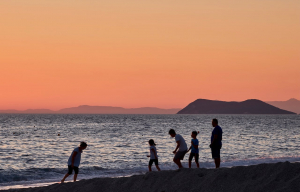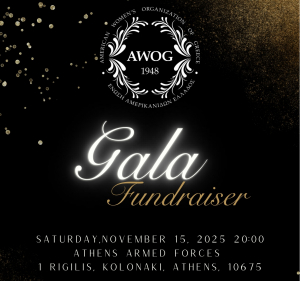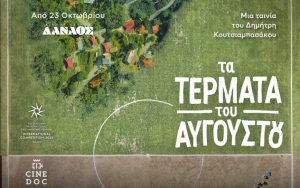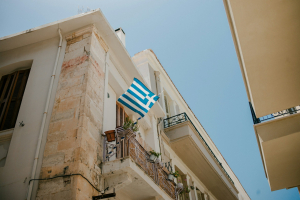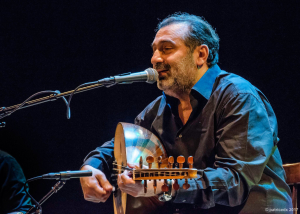SUPPORT US
XpatAthens
Children First
What American Expat Parents Should Know When Raising Infants In Greece
Understanding Maternity, Parental Leave, and State Support
Greece has expanded support for new parents in recent years. In 2024, the government raised the tax-free income threshold by €1,000 for families with children. It also extended the maternity allowance from four to nine months and increased the heating allowance from €3,000 to €5,000 per child.
These measures aim to ease financial stress for young families. A key part of this support is the birth allowance, a one-time payment for every child born in Greece. Effective from 2024, the amount is now graduated. For the first child, parents receive €2,400, rising to €3,500 for the fifth and subsequent child, providing meaningful relief for growing families.
If you’re an American living and working in Greece, you may qualify for certain local benefits depending on your residence and employment status. Parents who contribute to Greece’s national insurance (EFKA) can apply for maternity and parental leave allowances. Eligibility often depends on your work contract, so confirm with your employer or local EFKA office.
Families also receive child benefits that vary by income and family size, ranging from about €28 to €70 per child. These payments are made six times annually in bi-monthly installments by OPEKA. Applications must be submitted through the government’s digital portal. Local municipalities and expat groups can help guide you through the process.
Infant Formula, Pricing, and Regulation in the Greek Market
Many expat parents are surprised by how expensive infant formula is in Greece. According to Le Monde, an 800-gram container of powdered formula can cost up to €27, nearly double the price in other European countries.
Newsday Greece reports that the rising prices forced the government to implement a 7% profit cap on baby formula. Greek authorities also fined several international companies for violating these caps. For parents, this means pricing is now more regulated, but selecting the right formula still requires care. When buying baby formula, always check for EU labeling and safety approval.
Pharmacies across Greece stock many EU-certified brands, and pharmacists can help you choose the right one for your baby. Imported U.S. brands are harder to find and cost more. Many American parents follow product safety news back home. You may have read about the Similac lawsuit in the U.S., which raised concerns about specific infant formulas.
According to TorHoerman Law, various Similac products were linked to necrotizing enterocolitis, a severe intestinal condition in premature infants. However, this case applies only in America and does not affect Greek or EU-regulated products. Still, staying informed about recalls can help you make safer choices, especially if you import formulas from abroad.
Food safety in Greece follows strict EU standards, and local products are regularly inspected. If you live on an island or in a rural area, keep an extra tin or two, since delivery delays are common during peak seasons.
Healthcare, Pediatric Access, and Vaccination Norms
Greece has both public and private healthcare systems, and expat parents often use a mix of both. The public system provides reliable pediatric care through regional hospitals and health centers, but wait times can be long. Private clinics, while more expensive, offer faster appointments and English-speaking pediatricians.
To access public healthcare, register with the national insurance system (EFKA) and obtain an AMKA number. This gives your family access to child health visits and vaccinations. Most vaccinations in Greece follow the World Health Organization’s schedule, so you won’t find major differences compared to the U.S.
A helpful tip for expat families: in many Greek neighborhoods, pediatricians still make house calls for newborn checkups. This can be a big comfort, especially during your baby’s first few weeks. Local parent groups can recommend trusted doctors who speak English or are familiar with the needs of foreign families.
If you plan to split time between the U.S. and Greece, carry a record of your baby’s vaccination history to avoid duplication. Pharmacies in Greece also provide over-the-counter baby medications, but you’ll need a doctor’s prescription for antibiotics or specialized formulas.
Once your child’s healthcare needs are met, the next challenge is managing day-to-day essentials such as formula and supplies, especially outside major cities.
Managing Baby Supplies & Daily Life Across Greece
Outside of Athens and Thessaloniki, access to baby supplies can vary. Pharmacies are the primary source of baby formula, diapers, and baby care items. In smaller towns or islands, it’s smart to order in bulk or through online Greek pharmacies that deliver nationwide.
Shipping from the U.S. can be unpredictable due to customs and inspection delays. Rely on EU-certified brands found locally when possible. These products meet high safety standards and are easier to replace if lost or recalled. Island residents should plan around ferry schedules and delivery slowdowns, especially during holidays.
Keep a small emergency kit, formula, diapers, wipes, and basic medication, for times when stores close early or shipments are delayed. To understand daily living costs, consider the example of an American family that relocated from Texas to Greece. According to CNBC, they found life more affordable and balanced.
The family, earning about $136,000 annually, reported spending roughly $1,400 per month on rent and utilities. Additionally, they spend $1,900 on food and $1,200 on medical expenses during their first month. Although their initial relocation cost about $15,000, they described the Greek lifestyle as more fulfilling, and financially lighter compared to the U.S.
While day-to-day logistics can take effort, most expat families adapt quickly. Many American parents say that once they understand how local systems work, they find Greece a welcoming and supportive place to raise children.
Frequently Asked Questions
1. What documents do American expats need to access healthcare in Greece?
American expats need an AMKA number (social security ID) to access Greece’s public healthcare. You can apply for it through your local KEP (Citizens’ Service Center) with your passport, residence permit, and proof of address. Private health insurance is recommended to cover services not included in the public system.
2. What are the private childcare options for infants in Greece?
For infants under 4 years old, you'll find both municipal and private infant care centers (Vrefonipiakoi Stathmoi). Private crèches (daycare) can admit babies as young as 2–6 months, though public centers often start closer to 6 months. For personalized care, private nannies or babysitters are also widely available.
3. How can American parents find English-speaking pediatricians in Greece?
Most major cities, such as Athens, Thessaloniki, and Heraklion, have English-speaking pediatricians who cater to expat families. You can find them through private hospitals, embassies, or expat Facebook groups. Many clinics list English fluency on their websites, and some even offer telehealth consultations for added convenience.
Raising infants in Greece as an American expat comes with adjustments, but the rewards typically outweigh the challenges. Understanding how to access parental support, manage formula choices, and navigate healthcare will make your family’s transition smoother.
Greek culture deeply values children and community, so you’ll find many locals willing to offer advice or lend a helping hand. With the right preparations and local insights, you can create a safe, nurturing environment for your little one to thrive under the Mediterranean sun.
Great Escape Rooms Around Athens
1. Woman in Black – Coven Escape Rooms
📍 Sapfous 143, Kallithea
⏱ 1h 40m | Difficulty: 8/10 | Horror | Greek & English
Step into the haunted village of Grithin Gifford, where locals whisper about a mysterious woman dressed in black, a shadowy figure said to bring death to anyone who dares cross her path. You’re sent from London to find the will of the last tenant of the decaying mansion across the marsh road, but beware: some secrets are best left buried.
Not for the faint-hearted — this experience is strictly 18+ and not recommended for players with heart or breathing conditions, claustrophobia, epilepsy, or panic attacks.
2. Monika’s Diary – Bang Bang Theory Escape Rooms
📍 Aristotelous 19, Kallithea
⏱ 1h 30m | Difficulty: 9/10 | Horror | Greek & English
At just 12 years old, Monika disappeared without a trace after years of grief over her mother’s suicide. Her father, Frank, was left behind in the old family house, where strange sounds and shadows still linger. Now, years later, new evidence has surfaced, and the case is reopened.
You and your team are among the investigators stepping into the house to uncover what happened, but nothing is what it seems. And when a certain object comes alive… run.
P.S. Frank is one of the best actors you'll come across in an Escape Room!
3. Paradox Project 2: The Bookstore – Paradox Project
📍 Charokopou 93, Kallithea
⏱ 3h 20m | Difficulty: 9.5/10 | Investigation | Greek & English
One of the most acclaimed escape rooms in the world, The Bookstore is an epic, cinematic experience that continues the story from The Mansion and precedes The Music Academy.
After your last adventure, you’ve left something behind and the consequences are now catching up with you. Shadows from your past are closing in, and the line between truth and illusion begins to blur.
Awards:
-
#2 Best Escape Room in the World (TERPECAs 2019 & 2020)
-
#1 Best International Escape Room (Escape Room Awards 2021)
-
#1 Top Live Escape Room (Escape Roomers DE Awards)
-
Golden Lock Award (Room Escape Artist, 2020)
This one’s an absolute must-try.
4. Truth or Dare – Clock Escape Rooms
📍 Dorieon 7 & Lagada, Agia Paraskevi
⏱ 1h 50m | Difficulty: 9/10 | Investigation | Greek & English
In 2005, a drunken joyride after a graduation party ends in tragedy; a hit-and-run that’s buried deep in the past. Eighteen years later, the five friends responsible receive a mysterious invitation: someone knows their secret.
It’s a gripping psychological thriller full of moral dilemmas, plot twists, and dark revelations. Truth or dare, which will you choose?
5. The School of Burning Souls – Lockdown Escape Rooms
📍 Paleon Patron Germanou 12, Nea Ionia
⏱ 1h 40m | Difficulty: 7/10 | Horror | Greek & English
In 1986, tragedy struck Bloodwood Elementary School when a fire consumed everything, except a few survivors. Decades later, you return to uncover the truth of what really happened that night.
As you walk through the charred remains of your childhood school, memories and phantoms intertwine. Some ghosts never rest… and some memories are better left forgotten.
6. Anna’s Dream
📍 Eleftheriou Venizelou 111, Nea Ionia
⏱ 1h 30m | Difficulty: 7/10 | Séance Activity | Greek Only
If you’ve ever wondered what it’s like to sit in a real séance, candles flickering, whispers in the dark, and the feeling that something unseen is watching — this room is for you.
Unlike traditional escape rooms, here the goal isn’t to escape, but to enter another world. Guided by the story of a Victorian medium, you’ll be invited to communicate with her restless spirit and uncover the dream that haunted her until death.
Prepare for a unique, spine-tingling experience where logic takes a backseat to atmosphere, instinct, and courage.
7. Left Alone – Dark Matter Escape Rooms
📍 Aristidou 16, Agioi Anargyroi
⏱ 1h 40m | Difficulty: 7.5/10 | Horror | Greek & English
“My beloved grandchildren… when will you visit me?”
Haunting, emotional, and deeply psychological, Left Alone explores loneliness, fear, and regret through the eerie story of an elderly woman left behind. Is it just grief haunting this house or something much darker?
This room will stay with you long after you leave it.
Whether you’re chasing jump scares, solving intricate puzzles, or diving deep into cinematic storytelling, Athens’ escape room scene is unmatched. With hundreds of options scattered across the city, you can find a room that suits your mood, from light-hearted mystery to full-blown horror.
So grab your friends, steady your nerves, and prepare to get locked in. The real question is… can you escape?
Where Legends Live: A Day In The Athens Olympic Museum
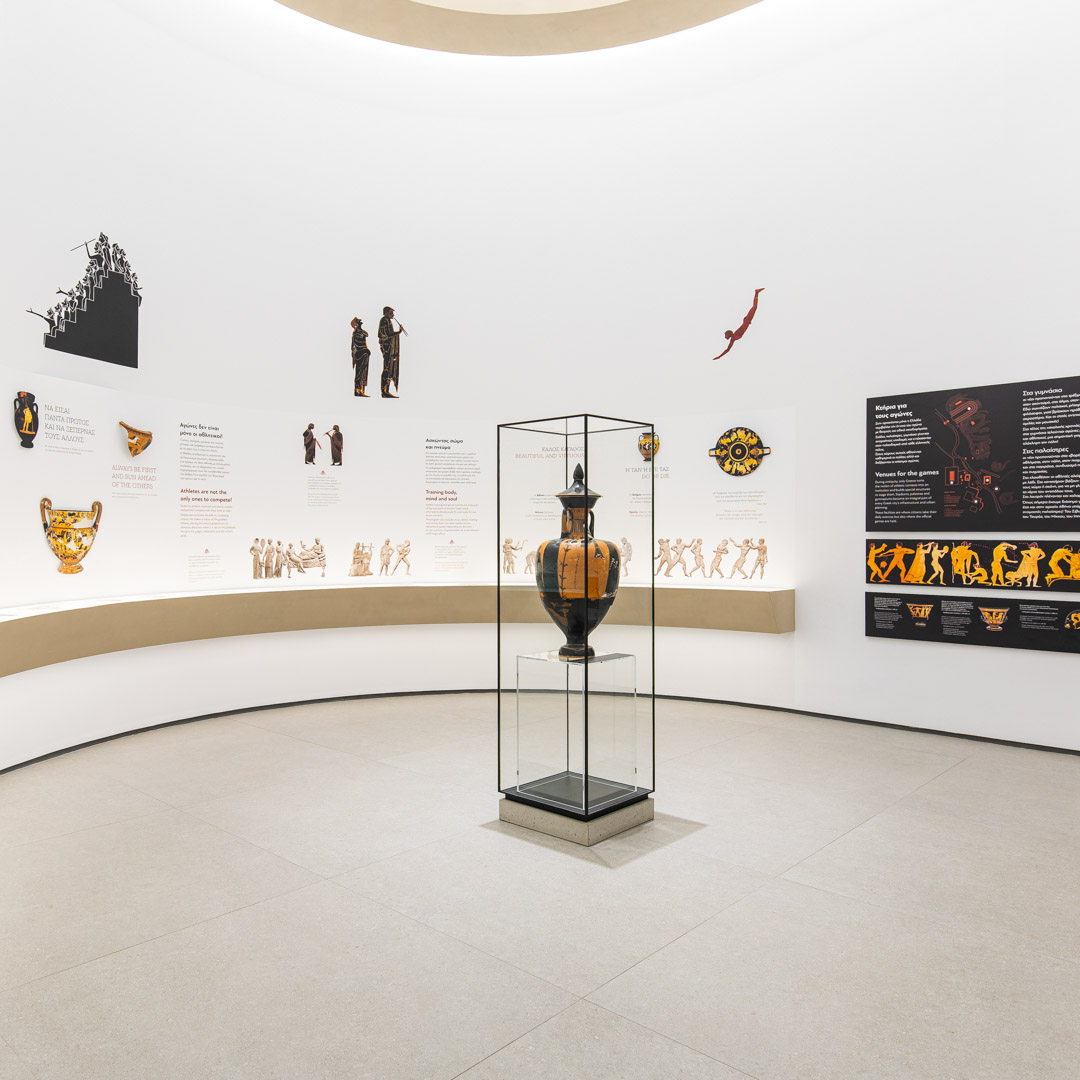
A Time Capsule Opens
The journey begins in a space that feels less like a gallery and more like a portal. The centerpiece is a 3D projection shaped after the κότινος, the olive wreath once placed on the heads of Olympic champions. Award-winning in its design using the technology of video mapping, the exhibit glows in the hushed light, alive with scenes and memories from past Olympics, accompanied by the music of Evanthea Reboutsika. Already, the past feels near enough to touch.
The second gallery resembles a cave, an otherworldly chamber where myths breathe again. Small “nests” shelter objects and stories: Hercules cleaning the Augean stables; Pelops charging forward in his chariot; the Curetes dancing, their shields clashing to drown out infant Zeus’ cries; and finally, the head of formidable Zeus, crowned with a wreath, a vision inspired by the lost golden statue.
From Myth to History
Stepping onward, we find ourselves surrounded by the world of competition throughout ancient Greek times. A great wall lays out the Panhellenic Games, not only the Olympics, but also the Isthmian, Pythian, and Nemean contests, as well as a special tribute to the Panathenaia. In this moment it becomes clear: this museum tells not just the story of the Olympics, but of Greece itself, and by extension, of the world.
On the opposite wall, Athens and Sparta confront one another in a timeless contrast. Athens proclaims καλός καγαθός, “beautiful and virtuous”, while Sparta answers with the uncompromising ἢ τὰν ἢ ἐπὶ τᾶς, “with your shield, or on it.” We also see an amphora, a faithful replica of those once full of olive oil, the treasured prize awarded to winners of the Panathenaic Games.
The fourth gallery adds a modern twist: an interactive video map. With a touch, we uncover the meaning of the sacred truce (ἱερή ἐκεχειρία) and read about the Discus of Ifitos, reminders that even in times of war, the Games called for cease of fire and harmony across the world.
Experiencing the Ancient Games
Then comes the fifth gallery, perhaps the most thrilling in the section of antiquty. Here, the stadium of Olympia unfolds before us in scale, and visitors are invited to run the δρόμος, the ancient sprint. High above, the statue of Nike by Paionios watches silently. The walls around us speak of rules: no biting, no foul play, and the ritual of ἀπαγορεύειν, where an athlete admitted his defeat by raising his finger.
The Hellanodikai, the judges of the Games, come into view, alongside the question: who could truly become an Olympic champion? At the tactile station, visitors can feel the shape of a κότινος olive wreath, or the crimson woolen ribbon once tied around the Olympic champions. The ribbon, it was believed, carried strength to its wearer. A “book of fame” completes the gallery, and we can turn the pages to reveal champions whose names still echo through time.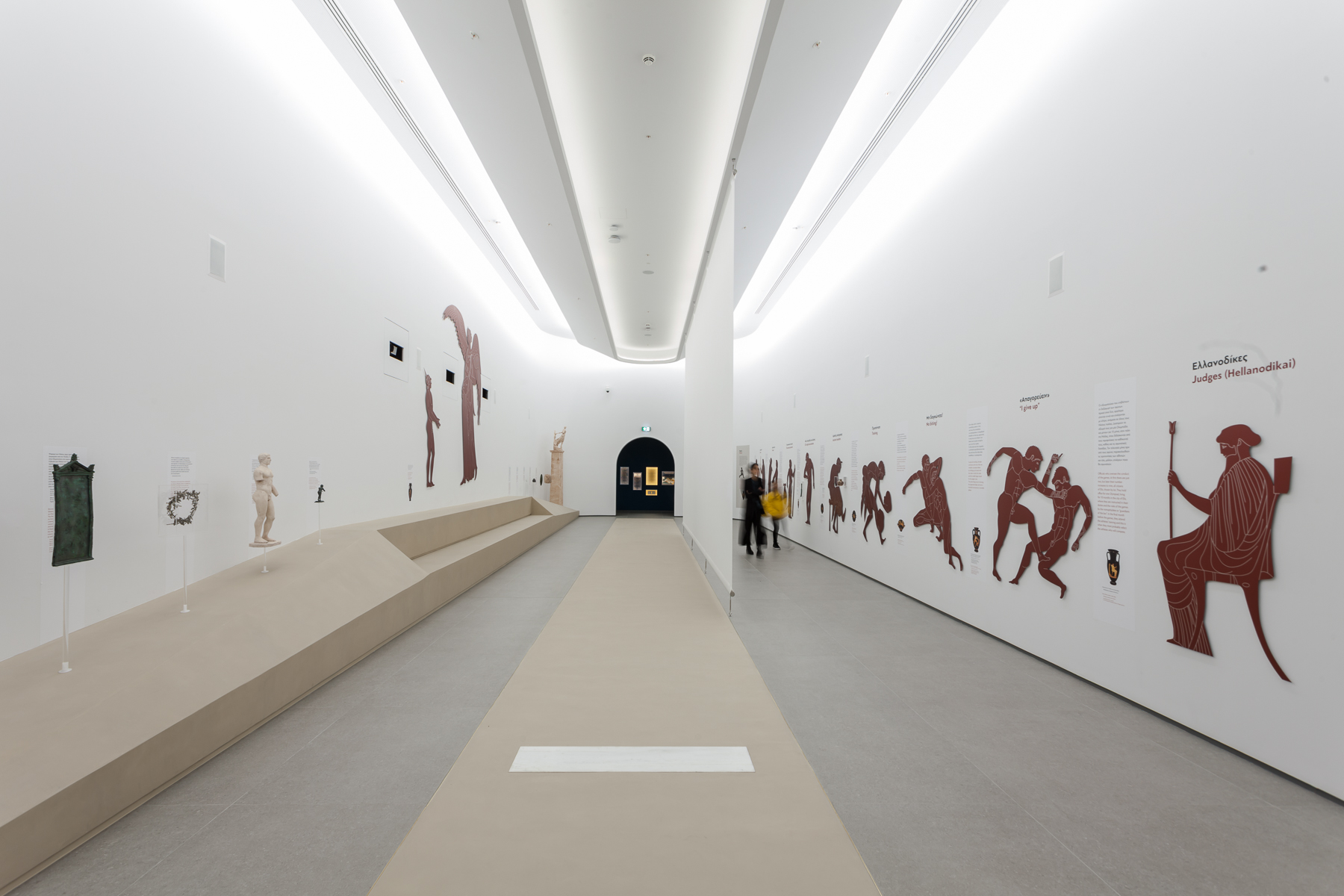
From Byzantium to the Revival
As we follow the route to the next gallery, the mood shifts dramatically. Designed to resemble a Byzantine church, with fonts, music, and aesthetics from the era, the gallery takes us from a period when the Games had faded and stopped, to the travels of the Europeans seeking to rediscover Olympia. A photograph of the excavations, bathed in light, symbolizes the rebirth of the ancient historical site.
The narrative continues with the path to the revival of the Games, leading us to Pierre de Coubertin and the Greek intellectual Demetrios Vikelas. Exhibits include extracts from their lengthy correspondence, Vikelas’ actual office desk, and a sizeable variety of documents from the 1896 Athens Olympics: letters, guides, flyers, and commemorative stamps on the occasion of that first modern celebration.
Into the Stadium Once Again
Next, we step inside a projection and exhibition hall designed as the Panathenaic Stadium. Sitting among its seats, we relive the atmosphere of the first modern Olympics. We learn how medals were originally awarded, with only the first two places recognized, as gold was introduced later in the history of the Games, and how participation was firstly limited to men.
We step into history as we learn all about the first modern Olympic Games of 1896. On the walls, we even see the figures of Harilaos Vasilakos and Spyros Louis, running towards the finish line—witnessing their struggle, their triumph, and their determination.
A Timeline of Every Games
In the next gallery, the story expands. A timeline of every Olympic Games edition - both Summer and Winter - unfolds before us, enriched with a collection of objects from each era, among which medals and athletes’ memorabilia. We learn so many meaningful facts and stories like how in 1932 Lake Placid, Mollie Phillips became the first woman to carry the British flag at the Winter Olympics. Or in 1964 Innsbruck, Italian bobsledder Eugenio Monti famously lent a part of his own sled to the British team, allowing them to win gold while his team took bronze, a story of true Olympic spirit.
Perhaps most exciting of all is the interactive touchscreens that let us explore what took place historically in the world during each Olympiad, proving once more that the Athens Olympic Museum is far more than a museum about the Games; it’s living chronicle of history itself.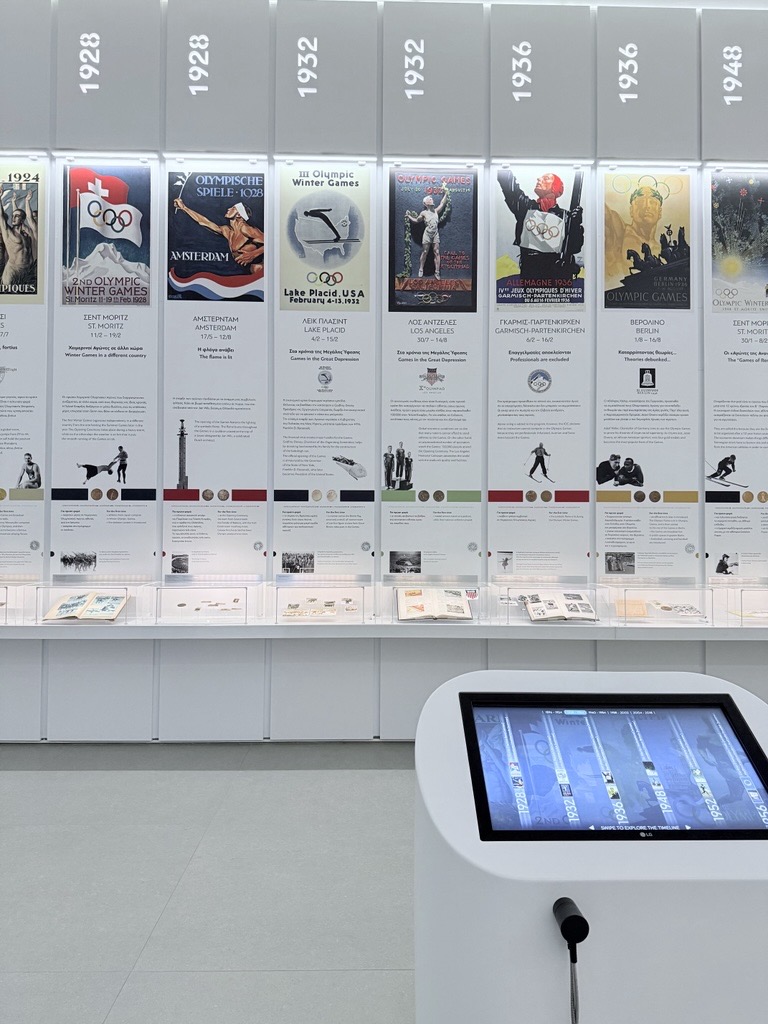
Athens 2004: The Games Return Home
Then, the journey brings us back home. The next exhibition gallery is an allusion to the Olympic Stadium of Athens (OAKA) and is dedicated to the Athens 2004 Olympics. We saw original sketches of Kouroudis’ Olympic sports “pictograms,” inspired by Cycladic figurines, as well as of the first medal engraving featuring Paionios Nike of Olympia ascending from the Panathenaic Stadium of Athens, designed by Elena Votsi; the permanent design of every summer edition ever since.
We follow the journey of the 2004 Olympic Torch Relay across all 5 continents, mapped in an artistic wall installation, and meet the mascots Phevos and Athena, inspired by the archaic ceramic daidala. On a video wall, we trace the massive public works that transformed Greece to host the Games.
The surprises continue: a parade of the original performers’ costumes, including the imposing Centaur, which the visitors can even touch, transfers us to the night of the Athens 2004 Opening Ceremony. Here also lies another treasure of memory, the medal of the decorated taekwondo Olympian Alexandros Nikolaidis, offered to the Museum for exhibition by his family.
And then, the focus shifts to the Athens 2004 Paralympic Games, presented through an audiovisual production and a collection of objects. A tactile station allows visitors to feel the 2004 Paralympics medal design featuring the Parthenon, and the neighborhood around the Acropolis, as well as a carefully reproduced larger tactile version making it accessible to visitors with visual impairments. This thoughtful detail captures the essence of the Games: accessibility, inclusivity, and the celebration of every athlete’s achievement.
Then the timeline of the modern Olympics continues in the next gallery where we encounter some empty slots waiting patiently to be filled with items of the future editions.
Kids will especially love the many close-up looks of the many mascots, before we see the Games motto in Latin that takes us to the next section of the exhibition. 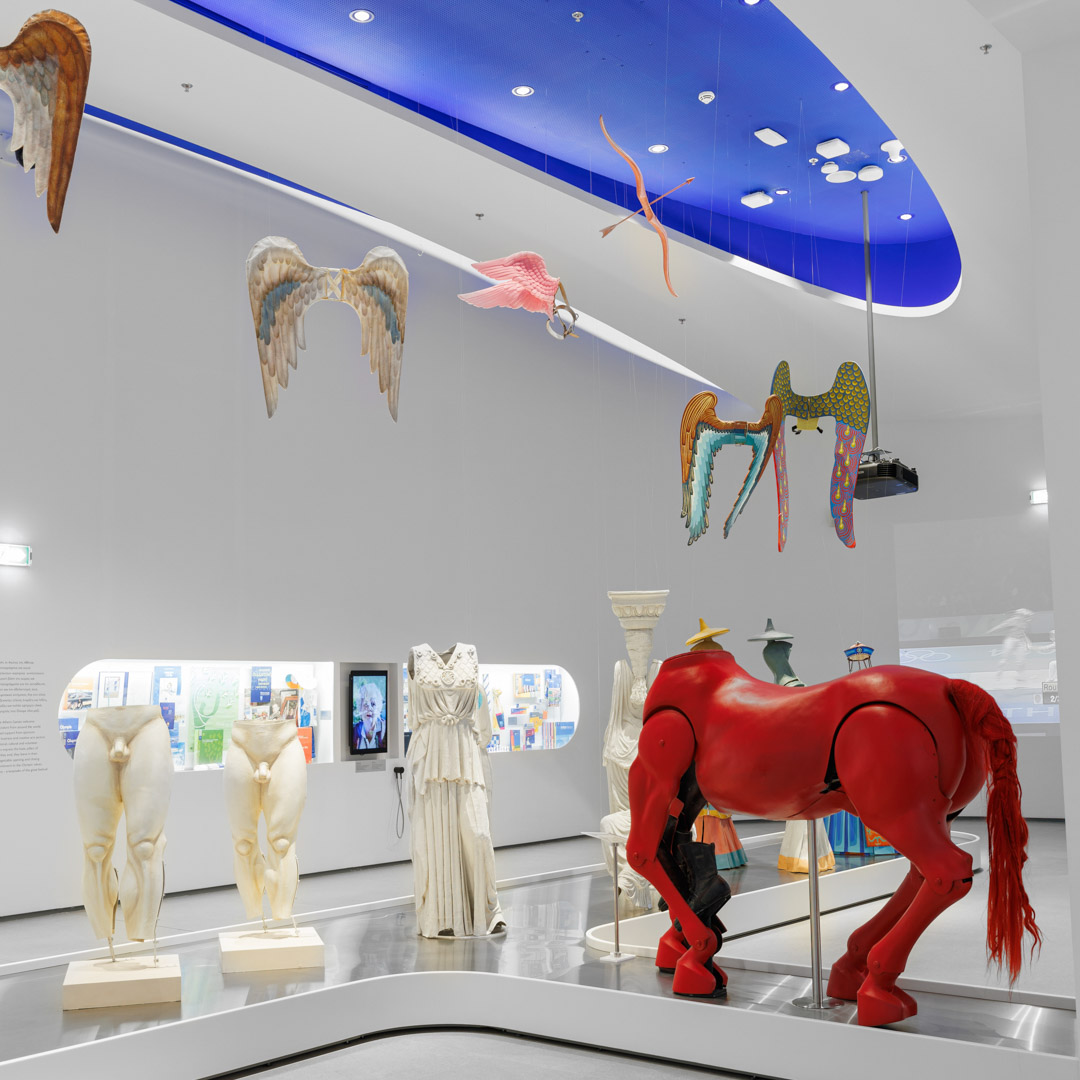
Symbols You Can Touch
The visit continues into a gallery where the Olympic symbols are presented together. Under the Olympic Flag we, again, find a tactile station, where visitors are invited to hold two original torches (δάδες) and to run their hands across the embossment of the Olympic rings symbol. For visitors with visual impairment especially, this is a revelation: the Games are not only something to watch, but something to feel, a universal language made tangible.
On display is the priestess’s chiton of Artemis Ignatiou, the current choreographer of the ceremony of the lighting of the Olympic Flame, a garment woven with tradition and ritual. Around us, the walls present the Museum’s collection of Olympic Torches, each design carrying its own meaning, each flame its own journey.
The visit in the gallery cannot skip the innovative central interactive installation, which received an Ermis award in 2021. It features a “seemingly unwritten” large book that come to life when its pages are flipped. The book is inspired by the Olympic Charter and vividly presents the Olympic Movement, the symbols and the philosophy of Olympism.
Stories Stitched in Fabric
In the next gallery, we find two large digital stations that let us dive deeper in discovering the stories of every Greek Olympic and Paralympic medalist, their victories, and seeing excerpts from their performances. Around the gallery we see their performance apparel and equipment from their participation to the Games, some instantly recognizable, others less known, like the Paralympic sport boccia. Before us the tribute to one of the legends: Pyrros Dimas, with the entire collection of the singlets he wore across his Olympic career. Then inclusivity takes center stage. At first glance, a simple piece of equipment whose purpose isn’t obvious. But then its significance soon emerges: it is the running tether worn by the blind sprinter Paraskevi Kantza, the link connecting her to her guide as they competed side by side. Suddenly, it’s no longer just an object, but a story of resilience, determination, trust, and teamwork. 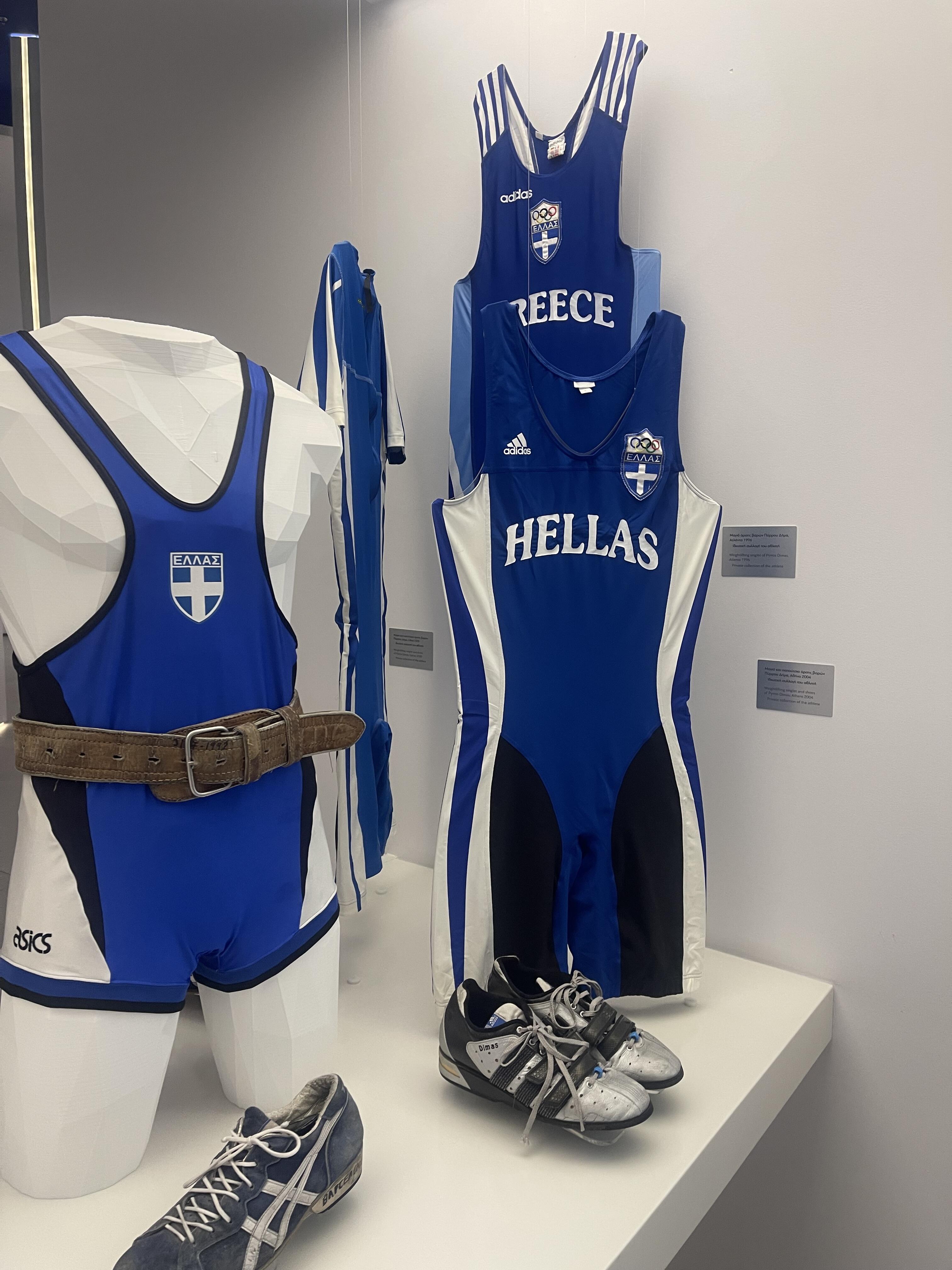
Become an Olympian
This is where the exhibition shifts from being a spectator to being a participant. We are invited to become athletes ourselves, to use a real Olympic bow in archery (Summer Olympics), to feel the rush of wheelchair racing (Paralympics), and to balance ourselves on the slopes in skiing (Winter Olympics).
For children, especially, this is a revelation: to learn by doing, to understand how difficult -and how extraordinary - the life of an athlete truly is.
The back wall glows with a Hall of Fame, but it is not only about medals and records. In the same gallery we meet athletes as people, their struggles as real as their triumphs. We learn about Michael Phelps, who faced the shadows of depression even as he stood on the podium and how Nikolaos Kaklamanakis thought his greatest rival was none other than himself. The exhibition host his sail of the 2004 Games, centrally presented in front of a mirror that is there to remind us that we too battle our own rivals within.
This is where the line between athlete and visitor blurs, as we can see our paths from the perspective of their stories.
An Inspiring Farewell
The exhibition closes with a large audiovisual show. An audiovisual production without words, without narration, sweeps across the large screen. We see some of the most powerful moments in Olympic history: the struggle of the athletes such as the emblematic barefoot marathon runner Abebe Bikila, the tears, the embraces, the impossible victories. With no explanation, only music, the images speak directly to the heart.
And so, the tour ends where it began, with silence, with awe, with the timeless flame of the Olympic spirit.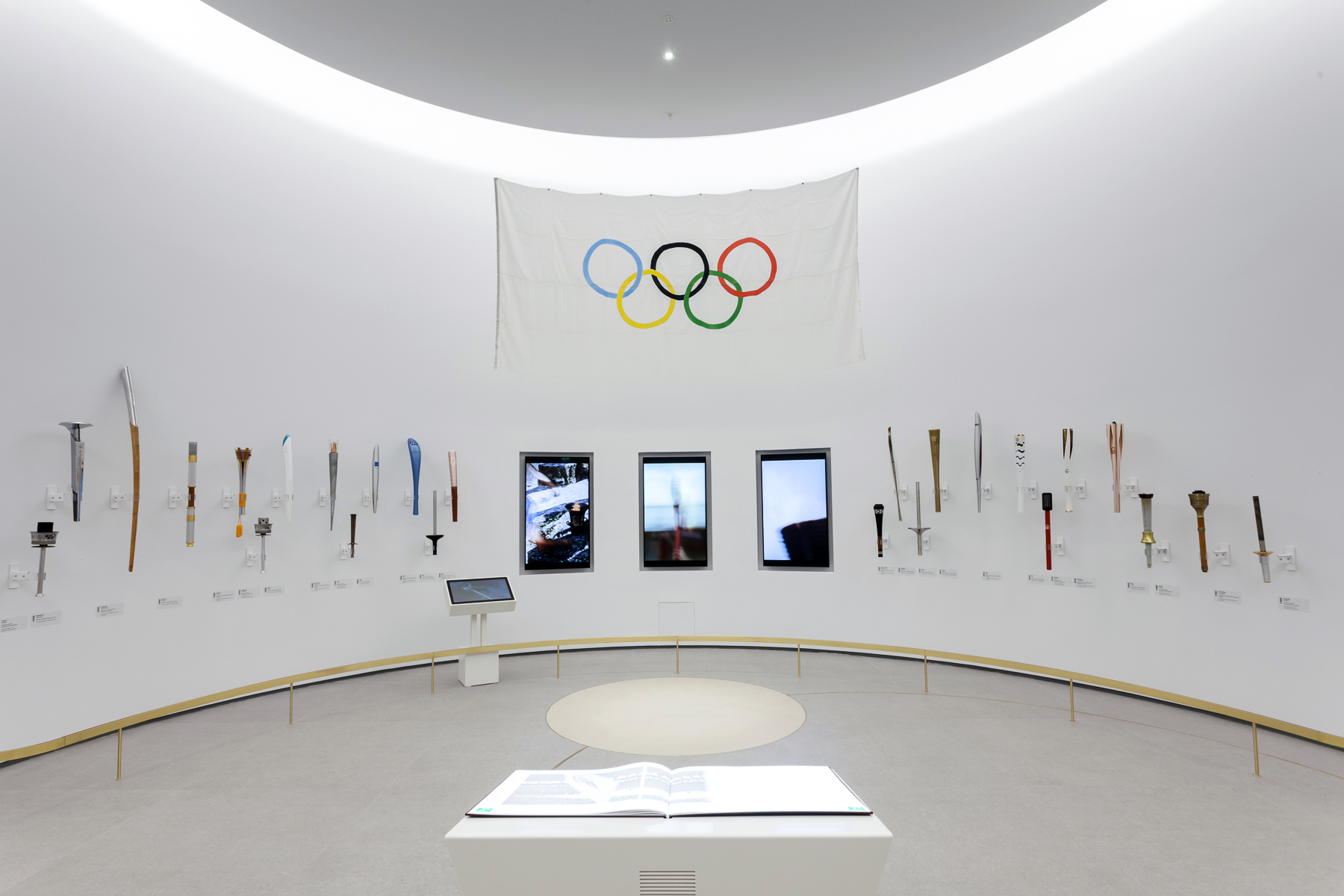
A Must-Visit for Everyone
What struck us most about the Athens Olympic Museum is how every detail has meaning. Nothing is random: every gallery, every symbol, every object is part of a carefully curated story. We loved how seamlessly it blends myth, history, personal stores and living memory into one journey. For children, blind and visually impaired visitors, the tactile stations, audio descriptions and narrations, as well as the interactive exhibits make the experience deeply, movingly inclusive and the Games’ stories accessible in a way that truly touches the heart.
The museum’s reach extends far beyond its walls. Its educational program “Μουσειοβαλίτσα” (AOM Suitcases) available in Greek, English, French, Arabic, and Farsi, brings the Olympic ideals to every classroom, group and community it reaches. Meanwhile, Live online Tours bring the history of Olympism to every corner of the globe. It’s a reminder of its mission to share values of inclusivity, excellence, and peace across languages and cultures. And yet, as much as we saw, we realized we had barely scratched the surface. The exhibition is so rich, the storytelling so layered, that the just one visit feels like an introduction, a welcome to the world of Olympism. We left with the sense that we must return, because there is always more to learn, more to feel, and more to discover in this place where history, humanity, and hope meet. The Olympic Museum is not just worth visiting; it is worth visiting again and again.
AWOG 2025 Gala
-
Date & Time: Saturday, November 15th, 8:00 PM
-
Location: A (Λέσχη Αξιωματικών Ενόπλων Δυνάμεων – Λ.Α.Ε.Δ. - Σαρόγλειο Μέγαρο), 1 Rigillis Street & Vasilissis Sofias Avenue, Kolonaki - Athens 10675.
This celebration is open to all, with reservations confirmed exclusively through the RSVP Form here and proof of bank transfer. Tickets are €60 per person (details below) and are non-refundable.
Dress to impress in elegant cocktail attire, arrive in style and shine with joy and be part of a night of celebration that truly makes a difference!
Important Notes:
-
Seating is not reserved.
-
Please note: GALA + [Your Name] on the bank transfer description.
-
Tickets may be transferred. If you cannot attend, kindly inform the person attending to provide your name at check-in.
-
This event marks another milestone for our organization and for that reason we would like to inform you that there will be a photographer.
Santorini Experience 2025 Concludes With Over 3,500 Participations From 40 Countries & 4 Continents
In this breathtaking atmosphere, and with ideal weather conditions, Santorini Experience celebrated its 10th anniversary, reaffirming its status as one of the top international sports tourism events worldwide.

World-class swimmers gathered in Santorini to test their endurance and technique on a course that combined speed, strategy, and breathtaking natural beauty. Each athlete experienced an unforgettable challenge that showcased both the competitive and emotional spirit of open water swimming.
In the race, Olympian Yasu Fukuoka from Japan claimed first place for the second time in the event’s history, followed by Dimitris Negris in second place, and Konstantinos Stamou (swimmer of SIXT) securing third place. Among the women, Maria Zafeiratou took first place, with Panagiota Giannakopoulou in second and Nora Drakou in third.
The swimming event was held in full safety in Santorini’s mesmerizing waters. The Santorini Boatmen Union played a vital role, assisting both in the execution of the race and the transport of swimmers from the Old Port of Fira to the Volcano starting point.
Participant safety was ensured by specialized lifeguards and rescue boats from the Lifeguard Patrol, Santorini Nautical Club, the Volunteer Rescue Team of Thira, and Caldera Yachting, which provided additional boats and staff to ensure the smooth and safe running of the event. The swimming activity was further supported by the Thira Port Fund, GeoThira, DEYATH (Municipal Water and Sewerage Authority of Thira), the Municipal Police, and the Loula and Evangelos Nomikos Foundation.
In collaboration with SIXT, a member of the MOTODYNAMICS Group, each athlete was provided with a mandatory safety buoy, further strengthening participant protection throughout the race. The Technical Director of the swimming event was Nikos Gemelos, an experienced coach with distinctions in the Olympic Games and World Championships.
Running with a View of the Aegean
The schedule featured three exciting trail races that gave runners a unique experience through Santorini’s picturesque alleyways and volcanic terrain — a route that blends dirt tracks with volcanic stone and offers constant, dramatic views of the Caldera. All courses started from the desalination plant in Oia, included challenging off-road sections, and finished back in Oia, allowing participants to discover Oia, Imerovigli and Firostefani along the way.
The three race distances were: the 5 km “Aristides Alafouzos” powered by Miele, the 10 km powered by SIXT, member of MOTODYNAMICS Group, and the most demanding 15 km powered by The North Face — each route revealing the island’s whitewashed houses, dramatic cliffs and unparalleled Aegean vistas.
In the 15 km race, George Dimoulas and Alexandros Tzoumakas (The North Face athletes) crossed the line together to share first place, demonstrating outstanding endurance and teamwork. In the shorter distances, Patryk Sobczyk from Poland dominated the day by winning both the 5 km and 10 km races, underlining his superiority over the shorter courses.
Women’s podiums were equally impressive: in the 15 km, Nikoleta Tzavara, athlete of The North Face claimed first place, in the 10 km, Deva Spyridoula took first place, and in the 5 km, Denisa Balla finished first, each athlete delivering excellent performances on the island’s demanding terrain.
Runners were energized before the starts by a warm-up session led by physical education instructor Mandy Persaki, which helped prepare athletes for the technical and scenic courses.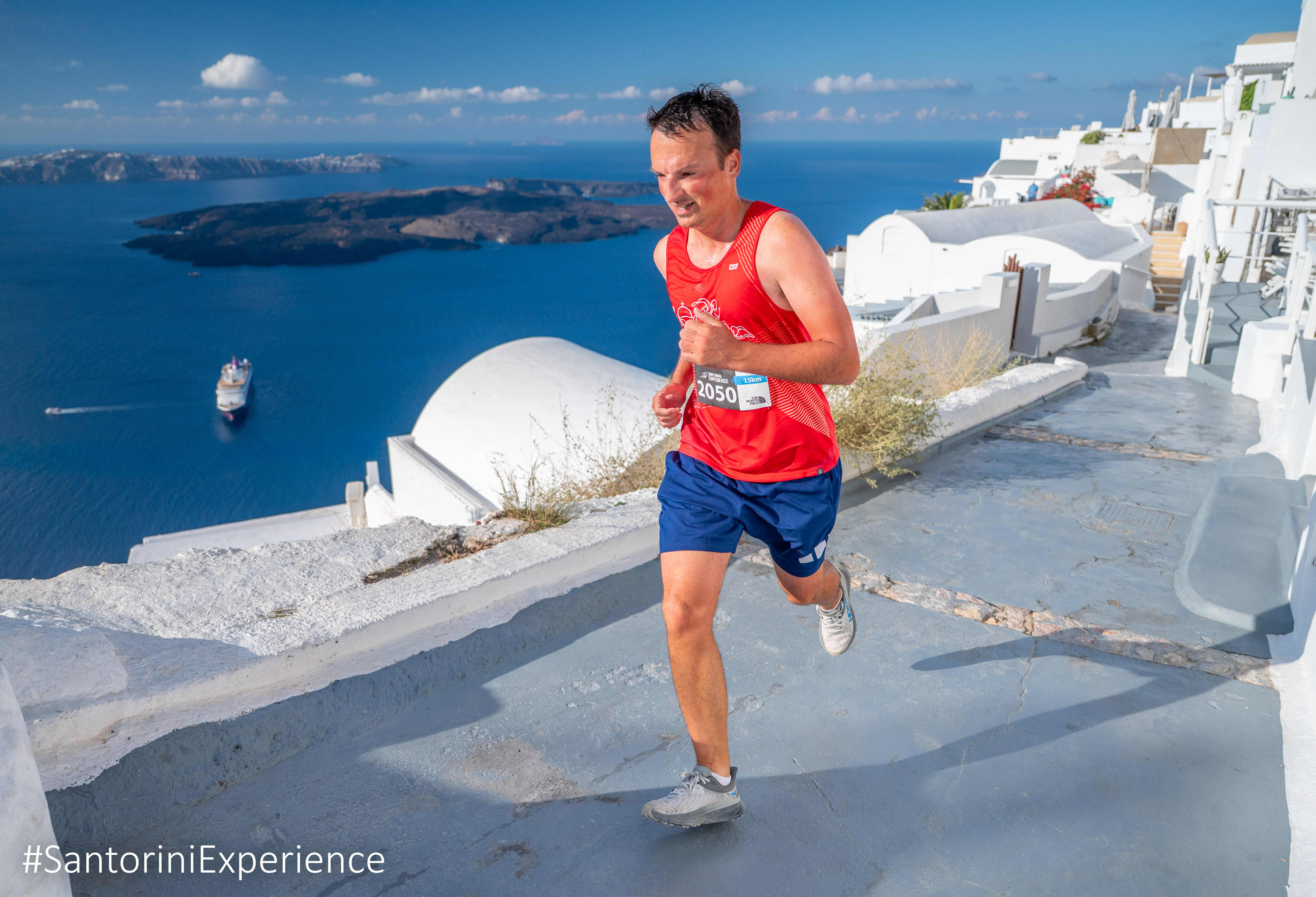
CLICK HERE to view all running & swimming results.
Within the framework of Santorini Experience 2025, the Mayor of Thira, Mr. Nikos Zorzos, emphasized the event’s importance for the island:
“It is a pleasure to see Santorini Experience continue to grow. Our goal is to maintain this course by promoting similar sporting events and extending the island’s tourism season. Santorini possesses unique characteristics — it is blessed by nature with an exceptional geological environment and distinctive landscapes. Santorini Experience offers an unforgettable experience for all participants, and we will continue to support sporting events so that sport can flourish on our island”.
Flag Football Makes Its Debut in Greece!
In parallel with the Santorini Experience, the NFL team Los Angeles Chargers inaugurated a new era for American football in Greece, presenting the first-ever NFL Flag Football Event.
The schedule included training camps for children aged 11–13 and teenagers aged 13 and above, through which young participants had the opportunity to learn the basic principles of flag football and test their skills alongside top athletes.
Spectators also enjoyed a spectacular exhibition game featuring former and active NFL players, such as: Melvin Gordon, former running back of the Los Angeles Chargers, Niko Koutouvides, Greek-American former linebacker and Super Bowl XLII participant, Melina Malaxos, Greek-Swedish player and coach, Members of the Greek Aegean Elite team, and Coaches of the Los Angeles Chargers. The event offered unforgettable moments for both young fans and adults alike.
The experience concluded with a special Watch Party, where guests watched the Chargers’ victory over the Dolphins live on COSMOTE TV, which holds the exclusive NFL broadcasting rights in Greece.
This initiative formed part of the broader effort to promote flag football internationally, ahead of its inclusion in the Los Angeles 2028 Olympic Games.
The introduction of American football to Greece was made possible through the active support of Stoiximan, which, as a Silver Sponsor, enhanced both the event and the island through its social initiatives. Stoiximan’s involvement promoted amateur sport, Santorini’s sports tourism, and the advancement of healthy athletic values.
During the flag football exhibition game, honorary awards were presented to:
- Dean and Michael Spanos, owners of the Los Angeles Chargers
- Mrs. Olga Kefalogianni, Minister of Tourism of Greece
- Athletes Melvin Gordon, Niko Koutouvides, Antigoni Ntrisbioti, and Constantine Karnazes, as well as
- The winning team, which received the MVP Stoiximan Award
The specially designed trophies were created by Spira Marble Art Gallery and sculptor Grigoris Kouskouris, based in Santorini, inspired by the island’s volcanic essence. The awards, crafted from marble—a material deeply linked to ancient Greece and prominent in the Olympic Games—symbolized tradition and perfection, bridging historical heritage with the modern era.
Mobility Session Powered by SIXT
In collaboration with JOINT Athens, Angelos Giakoumidis, and Giorgos Poulianitis, SIXT, a member of the MOTODYNAMICS Group, organized a comprehensive mobility seminar for participants, specifically designed for athletes and fitness enthusiasts. The session focused on techniques to enhance flexibility, improve posture, and prevent injuries, providing practical knowledge and skills for safe and effective training.
A Unique Hiking Experience to Ancient Thira
As part of the event, and with the support of Sandblu Resort as a Bronze Sponsor, participants followed a stunning hiking route to Ancient Thira. The trail crossed natural landscapes and offered breathtaking views of the Aegean Sea, combining the region’s uniqueness with the wild beauty of the natural environment — a truly immersive experience for those exploring both history and nature.
Over 1,500 Children Experienced the Joy of Sport
The Municipality of Thira enriched this year’s schedule with numerous side activities aimed at introducing young people to sport and healthy athletic role models.
For the first time at Santorini Experience, two sports icons visited the island to inspire children and bring them closer to the world of basketball: Evina Maltsi, Olympian and EuroBasket MVP, and Joe Arlauckas, legendary European champion with Real Madrid. On Sunday, October 12, at the Santorini Indoor Gymnasium, the Basketball Clinic powered by Trace ‘n Chase took place. Young athletes from the clubs Athlitiki Enosi Santorini and Poseidon Santorini met the international stars and learned professional techniques and strategies of basketball.
As part of youth education in Thira, Santorini Experience 2025 included lectures and activities by renowned athletes and professionals:
- Kostas Katsouranis, European Champion and Euro 2004 Legend, visited local football clubs Thyella Kamariou, A.O. Pyrgos, and Panthiraikos, inspiring young athletes with his experiences and values.
- Dimitris Papanikolaou, Olympian and European champion in basketball, and ambassador of the MOTODYNAMICS Group, shared insights on inclusivity in sports.
- Thanasis Chountras, motorsports coach, supported by the MOTODYNAMICS Group, visited schools in the municipality to educate students on road safety.
- Kostas Xiradakis, Chief Commercial Officer of Snappi, and Ioanna Tsekoura, Head of Customer Experience at Snappi, contributed to financial literacy for youth in cooperation with the Financial Literacy Institute, through the talk “What The Finance”. With Snappi’s support, participants gained inspiration, knowledge, and skills for personal development and financial management, enhancing the value of the event for the younger generation.
- Panagiotis Panoutsos Talkowski, Founder and CEO of EAGLE Sports Integrity Services, presented topics on sports integrity, promoting justice and ethical values. In addition, the collaboration with EAGLE made Santorini Experience the first recreational sporting event in Greece with a full integrity oversight system, including an independent Disciplinary Committee.
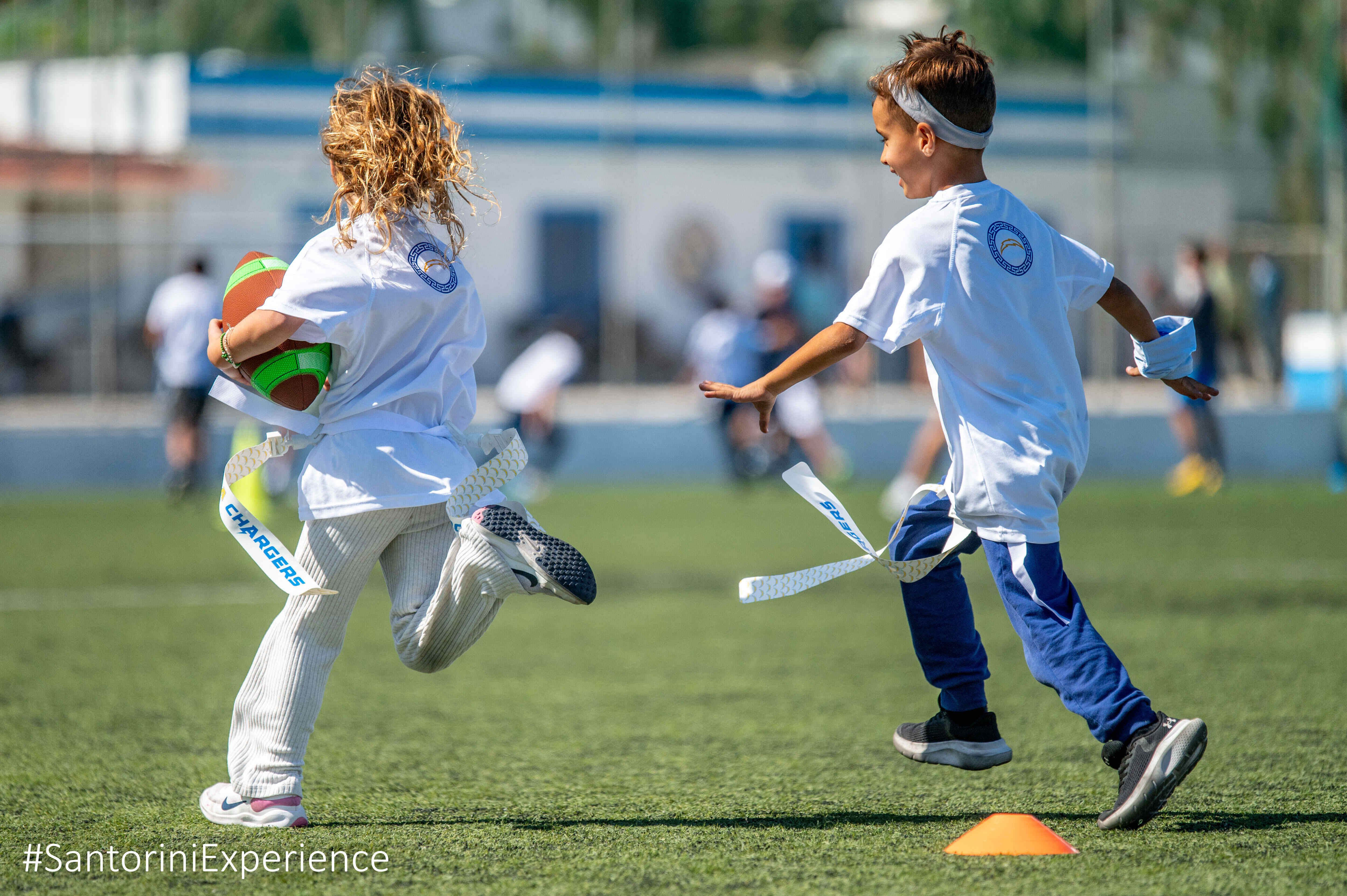
Sunset Party with Legendary DJ Vassili Tsili Christo
The Santorini Experience “Sunset Party” hosted DJ VASSILI TSILI CHRISTO in a thrilling musical session against the backdrop of Santorini’s unique sunset. For the first time on the island’s Caldera, the internationally acclaimed DJ Vassilis Tsilichristos captivated the audience with his energy and music, accompanied by the spectacular live performance of Angela ‘S’.
The event took place outside the Metropolitan Cathedral in Fira during the island’s most magical hour — “The golden hour of Santorini’s sunset”. Admission was free, offering both locals and visitors an unforgettable experience. Event supporters included: AESTIAN Philoxenia & Hospitality, Municipal Community of Thira, Rizes Gastro Taverna and Santorini Experience.
Additionally, the Sunday party on October 12 at Marilyn Bar provided another distinctive entertainment moment, with DJ 2Noicy energizing the crowd with dynamic music and rhythms, keeping the atmosphere lively well into the night.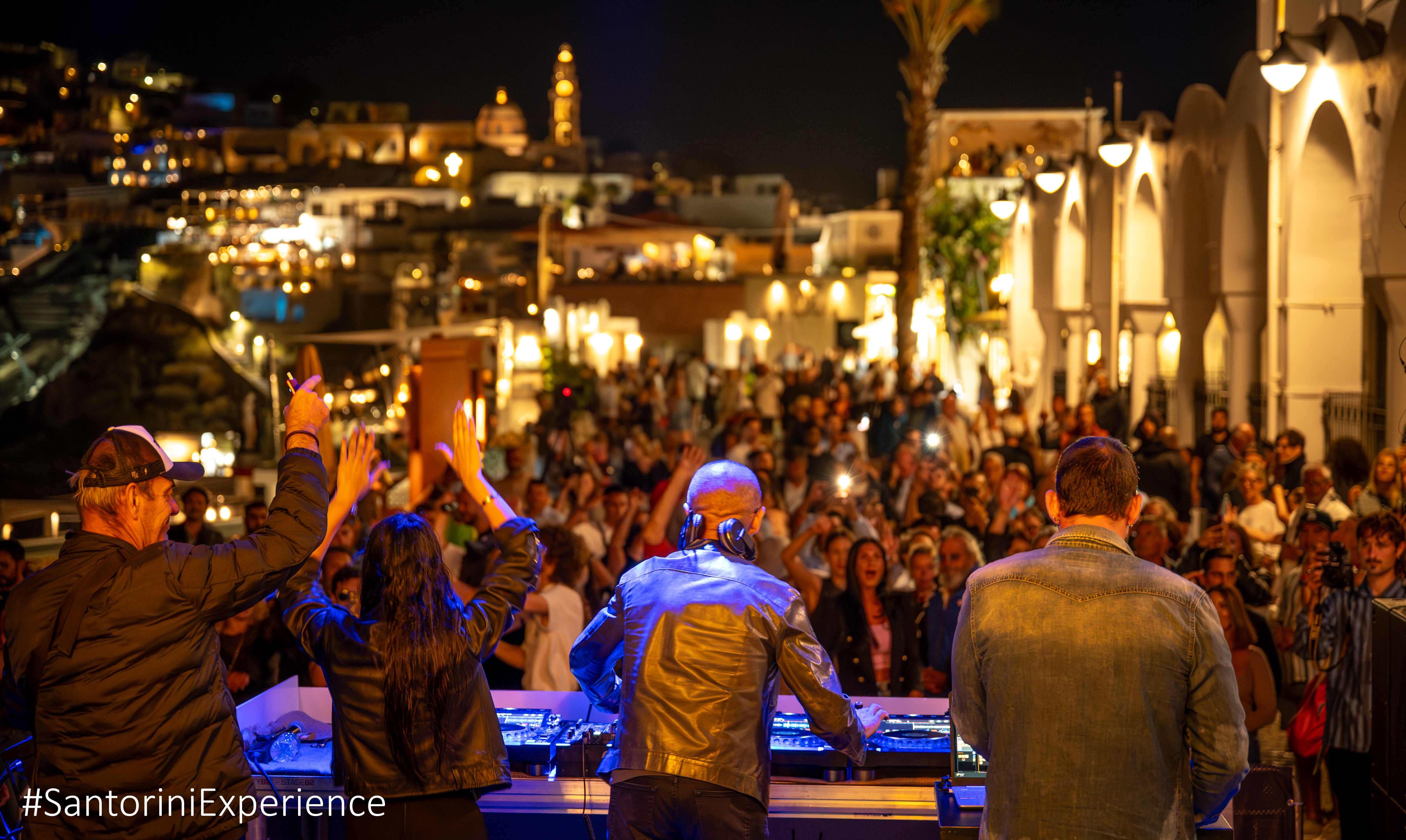
Unique Gastronomy & Sports Experiences
As part of Santorini Experience, gastronomy merged with sports, offering participants unique culinary experiences.
- At Rizes Gastro Taverna, a modern gastronomic destination, the authentic Cycladic cuisine was passionately highlighted. Each dish offered a distinct adventure of flavors, returning to the roots of tradition and the local produce.
- Exquisite meals were also served at Esperisma Bar-Restaurant, Nectar, Blu Restaurant, and Mylos Champagne Bar – Restaurant.
- The welcome cocktail at Esperisma Bar Restaurant allowed participants to enjoy refreshing cocktails and signature drinks, completing the experience with high-quality culinary enjoyment and atmosphere.

Collective Effort for a Flawless Event
Stoiximan supported the event and amateur sports across all activities, promoting participation and development of healthy sports at all levels.
Participants enjoyed comfort and quality services provided by VIP Santorini Tours & Transfers, which organized their transportation.
Emergency medical coverage was provided by the National Emergency Aid Center (EKAV), ready to respond if needed.
Official Partners & Sponsors:
Premium Mobility Partner: SIXT, member of MOTODYNAMICS Group
Gold Sponsor: AESTIAN Philoxenia & Hospitality
Silver Sponsors: Stoiximan, Miele, Snappi
Bronze Sponsors: Sandblu Resort, NOŪS Santorini, Blue Star Ferries
Official Airline Sponsor: SKY Express
Official Water: Vikos Natural Mineral Water
Official Trail Running Shoe: The North Face
Official Sports Store: Alafouzos Sport
Official Technical T-shirt: 42K
Jewelry Partner: Spanou Jewelry
Marble Sculpture Partner: Spira Marble Art Gallery
Sports Memorabilia Partner: Trace ‘n Chase
Official Optics Partner: Kois Optics
Official Healthcare Partner: Health Spot Diagnostic Center
Partners: Santorini Boatmen Association, Geothira, Caldera Yachting, VIP Santorini Tours & Transfers, Messinian Spa, Rizes Gastro Taverna, Nautical Club of Santorini, Anatomic Line, Voluntary Rescue Corps of Thira, Mylos Champagne – Bar Restaurant
Lifeguard Partner: Lifeguard Patrol
Integrity Services Provider: EAGLE Sports Integrity Services
Supporters: University of Piraeus, Humanity Greece, Deree – The American College of Greece, Municipal Community of Thira
Discount Partner: Marilyn Bar
Decisive Contribution of Hotels to the Event
The event was made possible thanks to the Hospitality Sponsors, who offered special rates and provided extensive support. Participating hotels included:
Athina Luxury Suites, NOŪS Santorini, Sandblu Resort, Katikies Garden Santorini, Vedema, A Luxury Collection Resort Santorini (Empiria Group), Santo Collection Resort & Villas, Apeiron Blue, Canaves Collection, 270 Oia’s View, Lydia’s House, Coco-Mat Hotel Santorini, Magma Resort Santorini, Aqua Vista Hotels, Caldera Collection, The Majestic Hotel Santorini (Kord Hotels), Thimari Lodge, Rocabella Santorini Hotel & Spa, Meltemi Suites, Meltemi Village, Atlantis Beach, Santo Houses, En Plo Boutique Suites, Mon Signor, Fanouris Condo, MONOLiTHIA, Epavlis Hotel (Meraki Collection), Eteoro Suites Santorini, Sea Breeze Beach Resort Santorini, K & K Unique Holiday Homes, Aja Retreat, Loizos Stylish Residences, Venus Sunrise Suites & Villas, Sienna Eco Resort.
The Power of Volunteers
Once again, numerous volunteer teams supported the event. Santorini Experience 2025 received support from: University of Piraeus, Humanity Greece, Deree – The American College of Greece, Voluntary Rescue Corps of Thira.
Economic Footprint Study
During the event, a study was conducted in collaboration with Deree – The American College of Greece to measure the economic impact of the event on Santorini. The results will be announced in the coming months.
The event took place under the auspices of the Ministry of Tourism and the Greek National Tourism Organization.
Santorini Experience was co-organized by: Municipality of Thira, Department of Sports & Culture of the Municipality of Thira, and ActiveMedia Group.
Official Hashtag: #SantoriniExperience
CINEDOC Presents: The Goals Of August
The Goals of August is a kaleidoscope of events, incidents, and moments from the everyday life of a village in southern Pindos during an improvised football tournament. The purpose of the documentary is to create, through observation, an “impressionistic” portrait of a small community as it comes alive in the summer — a portrait filled with both light and shadow, charm and, at times, unease. Despite its contradictions, it remains unexpectedly vivid and authentic, showing how a small community may stand nearly empty for most of the year, yet its spirit endures.
ATHENS – Danaos Cinema
Q&A following the screening with director Dimitris Koutsiabasakos, director of photography and editor Giorgos Fleggas, and Sotiris Tsoukarelis, Head of Social Innovation at Ta Psila Vouna.
Q&A to follow with director Dimitris Koutsiabasakos. The discussion will be moderated by Orestis Istikopoulos, sports journalist, and Alexandros Papageorgiou, film critic (Luben).
Q&A to follow with director Dimitris Koutsiabasakos and members of the Shedia Street Magazine team.
Q&A to follow with director Dimitris Koutsiabasakos.
Q&A to follow with director Dimitris Koutsiabasakos. The discussion will be moderated by Giannis Kantea-Papadopoulos, film critic (Athinorama).
Q&A to follow with director Dimitris Koutsiabasakos.
Q&A to follow with director Dimitris Koutsiabasakos. The discussion will be moderated by Makis Papasimakopoulos, radio producer and podcaster.
Saturday 8 & Sunday 9 November | 17:15
With the presence of director Dimitris Koutsiabasakos.
Wednesday 15 October | 19:00
With the presence of director Dimitris Koutsiabasakos.
Tickets available at the cinema box office and online HERE!
From 16 to 22 October | Daily at 19:30 & 21:30
The screening on October 16 will take place in the presence of director Dimitris Koutsiabasakos.
Friday 17 October | 20:00
With the presence of director Dimitris Koutsiabasakos.
Saturday 25 October 2025 | 20:00
With the presence of director Dimitris Koutsiabasakos.
Tickets available at ENTEKA – Digital Printing
More information HERE!
The Libraries Of Athens: Where History & Knowledge Meet
Equally inspiring — though on a grander scale — is the National Library of Greece, now housed at the Stavros Niarchos Foundation Cultural Center in Kallithea. Designed by Renzo Piano, the building itself is a work of art: a glass and marble structure that seems to float above the park, flooded with natural light. Inside, the library preserves more than a million volumes, alongside 15,000 periodicals and a precious collection of manuscripts that trace the history of Greek thought. It’s not only a guardian of the country’s literary heritage but also a vibrant public space where visitors can study, attend lectures, or simply enjoy the quiet rhythm of a modern reading room. The National Library offers both open access areas and special collections for researchers, as well as an electronic reading room that allows registered users to explore thousands of digital resources remotely.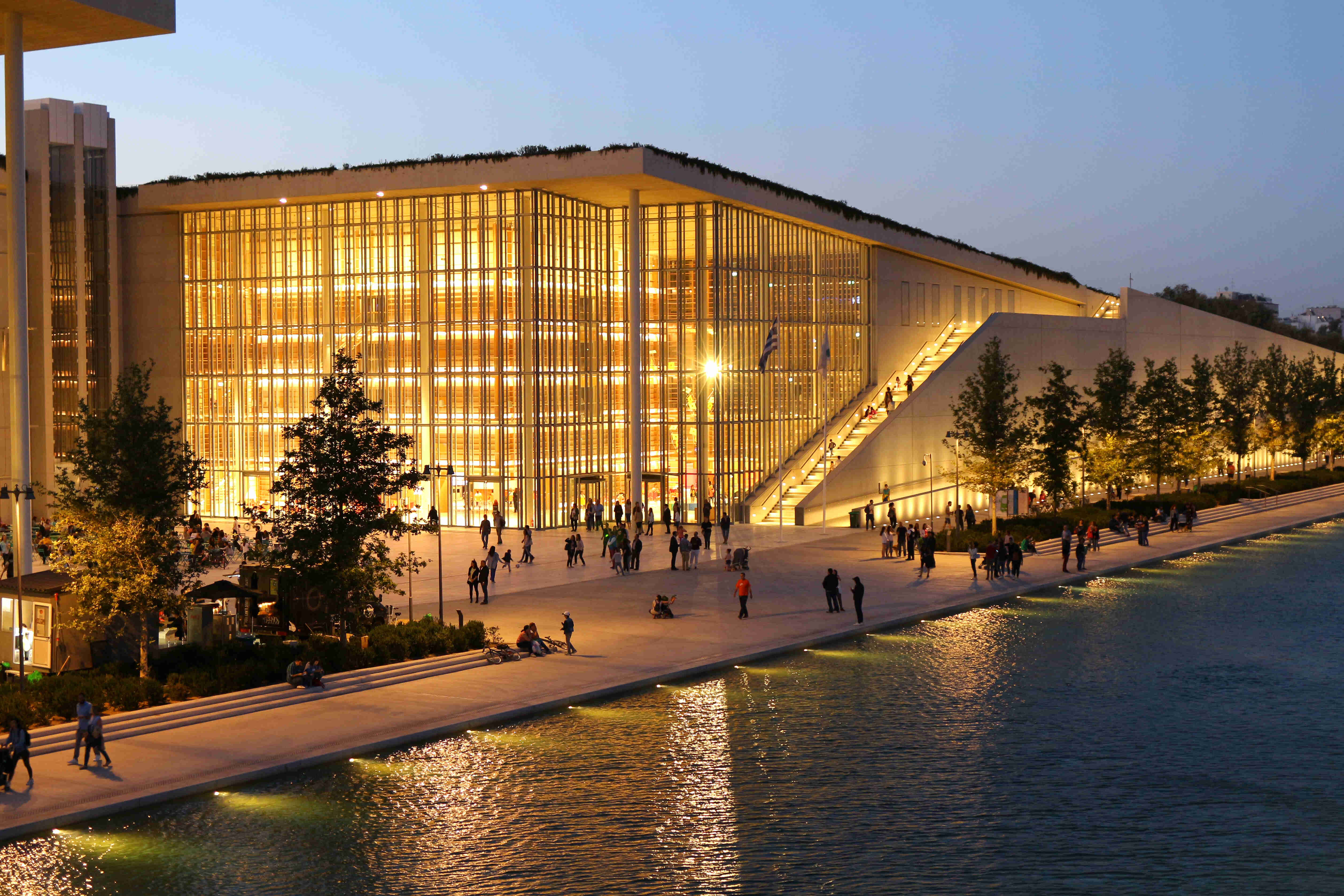
For those drawn to science and technology, the Eugenides Foundation Library offers a different kind of experience. Known for its focus on scientific and educational material, it provides a calm and beautifully organized environment for students, researchers, and curious readers alike. Registration is free, and members can borrow books, explore digital databases, or attend seminars that make complex topics accessible to everyone. The library is part of the Eugenides Foundation’s wider mission to promote science education in Greece, a goal reflected in its interactive exhibitions and planetarium next door.
The Gennadius Library, part of the American School of Classical Studies, offers another window into Athens’ intellectual heritage. Its elegant neoclassical building shelters more than 100,000 volumes focused on Greek history, art, and literature. Founded through the donation of the diplomat Ioannis Gennadios, it remains one of the most important research libraries for scholars of classical and modern Greece. Access is open to students and researchers, and even a brief visit reveals a uniquely serene atmosphere where history truly feels alive.
The Nordic Library at Athens is a remarkable collaborative effort between the Danish, Finnish, Norwegian, and Swedish Institutes in Greece. It houses around 40,000 volumes with a strong focus on archaeology, classical studies, and the cultural ties between Scandinavia and Greece. Beyond its extensive academic collection, the library also safeguards important archives, including the Calas Archive and the C.P. Cavafy collections, which feature letters, manuscripts, essays, and photographs that offer valuable insights into modern Greek literature and art. The Nordic Library serves as an indispensable resource for researchers and scholars working in the fields of archaeology, history, and cultural studies. While its facilities are mainly geared toward academic use, visitors may access the reading rooms and archives by prior arrangement. Those wishing to consult rare or archival material are encouraged to contact the library in advance to ensure availability and proper guidance.
The Onassis Library preserves rare editions dating from the fifteenth century onwards, along with the personal collection of Aristotle Onassis himself and the extensive Onassis Archive. It offers an intimate glimpse into the legacy of one of Greece’s most influential figures, while also serving as a space dedicated to the study of culture, literature, and history. Traces of Athens’ ancient love of learning can still be found in the Library of Pantainos, located in the Agora. Although now in ruins, it remains one of the few ancient libraries whose founding inscription, outlining its rules and use, has survived. Nearby stands the site of Hadrian’s Library, built by the Roman emperor in the second century AD. Once home to reading rooms, lecture halls, and gardens, it was one of the grandest libraries of its time. Today, its marble columns and courtyards remind visitors that Athens’ connection to knowledge and public learning stretches back thousands of years.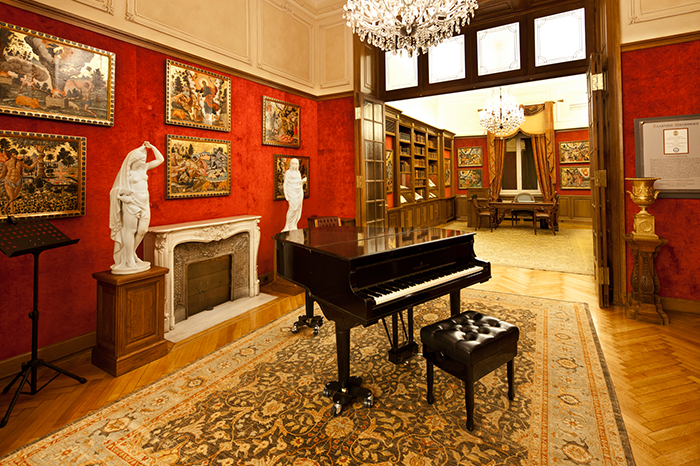
How To Master The Greek Language
Learning Greek can feel daunting, but with the right approach, you can not only understand it but truly master it. Greek is a rich and intricate language, and its beauty lies in its logic; once you start seeing patterns, everything begins to make sense. Here’s a roadmap to help you dive deeper.
1. Understand Greek Verbs and Their Core Themes
Greek verbs are built from core stems (themes) which form the basis for all their conjugations. Knowing these stems allows you to predict forms rather than memorize them blindly.
-
Example: φεύγω (“I leave”) has two stems: φεύγ and φυγ.
-
From φεύγ you get: φεύγω (present), φεύγοντας (leaving), θα φεύγω (I will be leaving)
-
From φυγ you get: έφυγα (I left), φύγε! (imperative form “leave!”)
-
-
Another example: έρχομαι (“to come”)
-
Present: έρχομαι
-
Imperative: έλα (“come here!”)
-
Future: θα έρθω (“I will come”)
-
Once you see these stems, even forms that look completely different at first become logical. This is one of the most powerful tricks for mastering Greek verbs.
2. Learn the Origins of Words
Greek words are often built from smaller roots. Understanding the stem can unlock the meaning of many related words. For example:
-
Καλημέρα = καλός (good) + ημέρα (day)
-
From ημέρα, we also get: ημερολόγιο (diary), ημερομηνία (date), ενημέρωση (update/informing), ημερήσιος(daily), even Ημεροβίγλι, the famous Santorinian village.
By tracing words back to their roots, you start noticing connections across vocabulary that make memorization easier and usage more intuitive.
3. Don’t Stay on the Surface
Many learners stop at basic phrases or vocabulary, but Greek truly starts to make sense when you dig deeper. Explore etymology, verb stems, and sentence structure. Once you understand the logic, you’ll see why forms exist, how sentences are built, and how words relate to each other.
4. Pay Attention to Nouns and Adjectives
Greek nouns are conjugated (declined) according to case, number, and gender, and adjectives follow the same patterns.
Example: Understanding how ο άντρας (the man/the husband) changes in different cases also helps you know how adjectives describing it will change.
-
If άντρας is the subject of the sentence, we use the nominative case.
-
If άντρας is the object, we use the accusative case.
For example:
-
“I called my husband” → Πήρα τον άντρα μου (here, άντρας is the object → accusative: τον άντρα).
-
“My husband called me” → Ο άντρας μου με πήρε (here, άντρας is the subject → nominative: ο άντρας).
Knowing these cases is essential for constructing correct and natural sentences in Greek.
5. Pronouns Are Key
Pronouns in Greek are powerful and often appear in shortened forms. Knowing them will make your sentences make sense and sound natural.
-
Example: Πάρε με = “Take me.” Here, με is the short form of εμένα.
-
Example: Πες μου = “Tell me.” We use μου instead of saying σε εμένα.
Recognizing these forms allows you to understand and speak Greek like a native, rather than piecing it together word by word.

